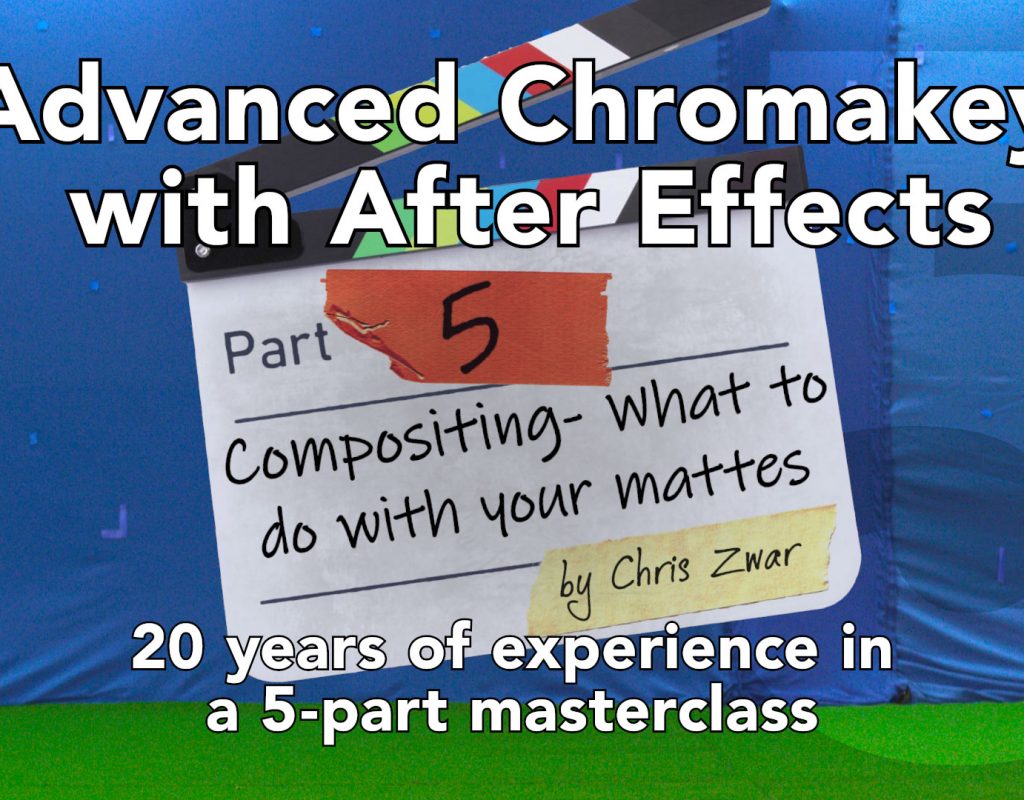In the fifth and final part of this series on keying, I’ll demonstrate a range of compositing techniques to help integrate keyed footage into backgrounds. In parts 1 to 4 we looked at a range of tips, tricks and techniques to get better keys in After Effects. Once we’ve keyed our clips and have a matte we’re happy with, there are a variety of additional processes we can apply to our matte, to make our composites look more realistic.
To be fair, this isn’t exactly a tutorial on compositing. It’s more about how to prepare your footage for compositing. Advanced compositing can use some or all of the following techniques demonstrated in the video:
- lightwraps
- edge lighting
- interlayer blur
- hair & semi-transparency glows
- volume rays
- spill as a light source
- basic colour correction – levels adjustments
- basic colour correction – colour as a blending mode
Attitude part 2: pre-composing
In part 1 of this series, I emphasized that I think the most important aspect of keying is attitude – and not expecting everything to be perfect with a single click. This philosophy is also the reason why I like to pre-compose mattes, as demonstrated in the video above. So my concept of “attitude” extends to pre-composing mattes, instead of using track-mattes in the main composition.
It is possible, with a bit of work, to build compositions that have lightwraps, edge blurs and so on without pre-comps. The problem is that you don’t have as much control over them, because your mattes are restricted to a single layer. When you make a pre-comp for a specific matte, eg lightwrap, you have all of the flexibility and power of a dedicated After Effects composition to manipulate the matte. You can add as many layers to the composition as you want to get the matte looking just right – you can use adjustment layers, other mattes and so on. However if you try and build a composition that does everything using only track mattes, and no pre-comps, then you’re limited to what you can do in a single layer. It’s easy to think of something that might make the matte look better, but it just becomes too hard and so you give up. By always pre-comping, you never have this problem.
Compositing in After Effects: Beyond keying
In addition to this tutorial series on keying, I’ve been publishing “After Effects project diaries” that give personal insights into real-world projects that I’ve completed. Several of these Project Diaries discuss compositing in After Effects in more detail, including examples where pre-composing mattes helps to make compositions cleaner and more organized.
Because of the way that After Effects works – it’s layer-based like Photoshop, as opposed to being nodes-based like Nuke – some of the techniques demonstrated above can be fairly involved, and require a complex web of pre-compositions. That doesn’t make the techniques any less important, just that After Effects has a relatively quirky rendering engine and visual fx compositing is a good way to encounter many of the quirks!
It’s a plugin, it’s an effect, it’s Supercomp!
Red Giant have just released their new “VFX Suite”, including a brand new plugin called “Supercomp”. You can read my review of the full VFX Suite here, and the review includes a quick demonstration video of why Supercomp is so revolutionary when compared to the traditional After Effects layer-based approach. The tutorial video for part 5 (above) is much longer and way more detailed, but it also serves as a demonstration of why Supercomp is so ambitious, and how it has the potential to completely revolutionise compositing in After Effects.
Supercomp includes 17 effects, including Optical Glow and volume fogs, which are outside of the techniques I demonstrate above. If you’re interested in advanced compositing in After Effects then the Red Giant tutorials are worth watching, and you should also download the trial version of the new VFX Suite to try it out for yourself.
What to watch now Game of Thrones has finished
This marks the end of the series on advanced chromakey in After Effects. Hopefully, having covered lots of ground, you’ve learned a few new tricks & techniques, and also gained insight into keying and compositing. It’s taken a long time to get this series together, and co-incidentally the launch of the new Red Giant VFX suite provides a great comparison of traditional compositing within After Effects to their new Supercomp plugin.
If you’ve missed the earlier parts then you can watch them here, starting with Part 1.
If you’d like to see more tutorials in the future, then please take the time to read through my other articles here on the ProVideo Coalition!

